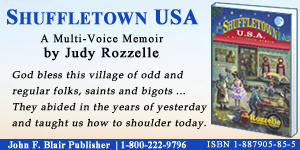Gather ’round, come with me back to a time when the land hereabouts was still wild and unknown; to a forest filled with wolves, wild turkey, and bobcats, where the roots of ancient oak trees stretch across the land like bony fingers and the unrestrained Catawba River runs deep and unbound through the land. Not far from here, an army of ghosts and angels serves and protects a sacred church.
The year is 1865 and the Civil War is drawing to a close. Robert E. Lee has surrendered, but Union soldiers have been ordered to destroy the Confederate Navy Yard in Charlotte (although Charlotte, obviously, is not a port, the Confederate States of America constructed a naval production facility in the city. Weapons, ships and other items for the Confederate Navy were built in Charlotte then shipped elsewhere.) Four units of hard-riding, hard-hitting Union cavalry, calloused by the war, are thundering towards Charlotte. Their instructions are to ride at night and hide during the day. Given orders to burn the armory and destroy all who try to stop them, coming from four different directions, they rode like the wind. It was even rumored that Gen. Sherman was riding up from Columbia to meet them.
Within two days, three of the Union companies were captured by the rag-tag Confederates operating in the area. Only one unit still rode on, towards Charlotte, and they came from the western mountains of North Carolina. They had made it into Gaston County and, on this foggy and cold morning, they were not stopping.Funeral fight
Coincidentally, at daybreak, the members of St. Joseph’s Mission are gathered to bury John Cox, one of their own. A Civil War soldier, John Cox had been killed defending Richmond, Va. His body had been placed in a rough wooden coffin and brought by rail and wagon to the church yard.
Almost every member of the church was present, but still there were less than 20 people in attendance, including women and children. Most of their men had been killed in the war and the hard winter had taken its toll on the women and children left behind.
Sgt. Pierce Cahill was home nursing recent battle wounds, but he was present for the funeral. He was leaning against a tree trunk in sorrow and pain. Only the mourning doves broke the silence with their lamenting call.
The Union soldiers had not made good time during the night. The fog was as thick as pea soup and it was impossible for the young lieutenant leading them to see his soldiers. Only the sound of the horse’s hooves assured him that they were there at all. Their horses had stumbled on the rutted roads and a thick fog shrouded each rider in a lonely damp world. They were weary, hungry and wet.
In the original plan, the riders were to ford the Catawba River above Rozzelles Ferry, but the fog caused them to miss the turn. However, they had among them a sympathetic southerner who was guiding them to Thompson’s Ford on what is now NC Highway 73 that runs by St. Joseph’s Mission. Here they would turn south, towards Charlotte.
As the riders followed the wagon trail toward Thompson’s Ford, John Cox’s body was being lowered into his grave. An owl hooted and Sgt. Cahill glanced up, suddenly, sensing danger.
“Hide. Hide now,” a voice hollered from the direction of the road. A young man rode out of the mist. He jumped off his horse and said, “There are Union soldiers coming this way. They are armed and dangerous. You will be killed.”
John Cox’s body was abandoned and the women and children rushed inside the church. Sgt. Cahill took command. He ordered the men and boys to crouch behind the rock wall with their weapons. They waited in the mist until they heard the riders. As the riders rounded the curve above the church, the sun burst through the clouds revealing the Union soldiers. The rag-tag militia stood and fired the only round of ammunition they had.
Fast retreat
The Union lieutenant suddenly held up his hand, hollered, and halted the soldiers. He turned his horse and rode wildly back down the road shouting for his soldiers to follow. The Union soldiers did not fire a shot in the direction of the church. They rode quickly back into the curtain of fog.
The sun disappeared behind a grey cloud and the fog closed around the retreating soldiers. They rode as if they were being chased by the Devil himself. Not one shot was fired in the direction of the rock wall at St. Joseph’s Church. Not one soldier or horse was hit by the church’s rag-tag militia.
The Union soldiers were captured shortly thereafter, having ridden right into a Confederate Army unit led by General Robert Johnson. When the chaos, shooting and shouting ceased, General Johnson asked the Union Lieutenant what had they been running from in such a hurry?
The Lieutenant replied that down the road at a small church they had been fired upon by more than 60 men in white uniforms from behind a rock wall surrounding a church. He recounted how two rows of these ghostly apparitions had challenged them as they rode towards Thompson’s Ford and, to save his men, he had hastily retreated. General Johnson sent a soldier back to the church and discovered it had been only a few men defending the church, the mourners, and John Cox’s body. The defending force was far short of 60 and none wore white.
Two stories
I do not doubt that there was a ghostly army.
You see, this story comes by way of Carl Heil, the church’s faithful caretaker. He was told this story of that fateful and mysterious day by a 90-year-old woman who stopped by the church one afternoon to visit the gravesites of relatives. She was accompanied by her 70-year-old nephew who had driven her to the church, from Georgia.
It was by chance that Carl was at the church that day when the woman arrived. He listened, amuse and amazed, as the women told their tale. It was only after the left, however, that the story began to take on a new meaning.
Carl remembered a similar tale of the Civil War that he had heard as a child. It was an account of the same battle as told by his great grandfather, Edward Craver. As the two tales began to merge in his mind, Carl began to shiver. Suddenly, he knew that this tiny North Carolina church that he had served so faithfully was the same church where his great-grandfather had once confronted ghostly soldiers.
You see, Carl Heil grew up in Syracuse, N.Y. His great-grandfather, Edward Craver, fought for the Union Army in the Civil War. He had mustered into the army at Fort Gibson, N.Y. Carl remembers how his great-grandfather loved to tell of his adventures during the war. There was one story he would always avoid, unless his great-grandfather’s wife teased him into telling it.
“Go on,” she would say, “tell them about the church in North Carolina where your company encountered 60 soldiers dressed in white uniforms.”
Finally, his great-grandfather would admit that he had been with Union soldiers that had confronted a strange and ethereal army behind the rock wall of a small church in North Carolina. But he would not talk further about the incident.
“My great-grandmother always told him that they must have been drinking Southern moonshine,” Carl says. “Everyone is dead now and I can’t prove this tale, but I know it is true.”
In mathematics, two angles that fit together perfectly are said to coincide. Is it coincidence or providence that Carl Heil, a native of Syracuse, N.Y. and resident of Los Angeles retired to Charlotte to become the caretaker/guardian of St. Joseph’s?
I choose to believe that the same angels and saints that protected St. Joseph’s that foggy morning brought Carl full circle. Today, they stand with Carl protecting and caring for this holy place, this graveyard of children, fathers, grandfathers, mothers and grandmothers.
Ferry Tales Column, Mt. Island Monitor



[…] Original post found here […]